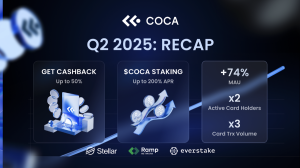Session Overview: Decentralized Messenger App and Its Role as DePIN

Imagine someone listening to every conversation you have — recording, storing, and analyzing it. Unsettling, right? And it’s not just about passwords or sensitive information (which you shouldn’t store in messengers anyway). It’s also about your private life and personal information, such as your location, address, phone numbers, and the chats or groups you manage, for example if you’re a media person, as well as other identifiable personal details.
All of this creates a serious digital security problem with typical Web2-powered messengers. In this overview, you’ll learn about Session — a DePIN project that includes a decentralized messenger. We’ll explore its main features, how it works, and its real-world impact.
What is Session?
Session is an open-source, blockchain-powered messenger app that was officially launched in 2020. Since then, the project has grown to over 1 million users globally. The app is available on Android, iOS, Windows, Mac, and Linux, with localization support for more than 70 languages and dialects.
Session is built to provide users with full control over their data and anonymity in the messenger, using end-to-end encryption and decentralized data storage. Simply put, users can chat, call, and create group conversations — all with the confidence that only they and their intended recipients can access the content.
Beyond that, Session is entirely people-powered: users around the world run nodes that make the messenger work. These Session Nodes are part of a decentralized infrastructure and reward their operators with crypto incentives. The next section breaks down how this works in detail.
Core of the Messenger App: Session Network
The Session Network is a Decentralized Physical Infrastructure Network (DePIN) that serves as the key element of the messenger. It runs on a Proof-of-Stake consensus mechanism. Users can stake the network’s native token (SESH) and install Session Nodes, which are responsible for delivering messages and enabling decentralized data storage.
As of now, there are over 1,500 nodes active across more than 50 countries, making the network decentralized and highly distributed — meaning it’s not controlled by any single organization.
Kee Jefferys, Co-founder: “There’s a required stake to run a node in the Session network, so it’s not like Tor where someone can spin up thousands of nodes and compromise the system.”
SESH Token: Backbone of the Session Ecosystem
SESH is the native utility token of the Session Network, deployed on both Ethereum and Arbitrum One. It powers the messenger and plays a vital role across the entire ecosystem:
Security: SESH is used to operate nodes and participate in the network’s Proof-of-Stake consensus, making it a fundamental part of Session’s decentralization and security.
Staking & Rewards: Users can stake SESH and earn token-based rewards for supporting and securing the network. Rewards for the network come from a pool of tokens secured by a smart contract, known as the Staking Reward Pool. Currently, the pool has over 62 million SESH, which represents more than 25% of the token’s maximum supply (240 million SESH). The staking rewards pool is dynamic, and more tokens can be added as Session Token is used.
Access to Advanced Features: SESH unlocks premium messenger capabilities. Upcoming features include the Session Name Service (on-chain readable usernames) and Session Pro memberships, offering enhancements like increased file transfer limits, user profiles, and more.
Session Network Fees: When the additional features mentioned above (Session Pro & Session Name Service) go live, access to them will require payment in SESH — which will be fully burned. 90% of these burned fees will then be reminted and allocated to the Staking Rewards Pool, while the remaining 10% will be used to support protocol liquidity and scalability.
Staking and Participating in the Session Network
Users of Session can not only interact with the messenger but also support the network’s operation and security by becoming part of this DePIN network, earning native SESH tokens in the process.
You can register your own node as an operator, which is accessible to anyone with minimal server setup knowledge. The Session documentation provides a clear step-by-step guide on node registration, choosing a server with the required specifications, and launching the node. Additionally, all management is available through a web-based Staking Portal featuring a simple and user-friendly dashboard.
The required staking amount to run a full node is 25,000 SESH, but you can also launch a node collaboratively with up to 10 contributors. If you are a node operator with contributors, you can set a custom operator fee to cover node expenses.
To participate as a contributor, you need to stake at least 25% of the staking requirement (6,250 SESH). As a contributor, you don’t need to set up or maintain a server. Instead, you can stake by connecting your wallet to the web-based Staking Portal and selecting an available node.
Staking SESH Without Running a Node
You can earn staking rewards by participating in the Session Network without running a node, technical skills, or high minimum staking amounts — simply by joining an available node as a contributor.
Staking involves just three simple steps:
Have SESH tokens in your wallet (e.g., MetaMask) on the Arbitrum One network (tokens can be purchased on Uniswap).
Connect your wallet to the Staking Portal.
Select a node from the list and stake your desired amount of SESH.
You will start earning SESH rewards within 24 hours after staking. Rewards can be claimed anytime via the Staking Portal.
Staker rewards come from the Staking Reward Pool, which currently holds over 62.9 million SESH — and this amount can grow through SESH utility. The pool turns token usage into staking incentives: using SESH for features like Session Name Service and Session Pro adds more tokens to it. Also, 14% of the pool is distributed to the network annually, calculated daily.
Key Features of the Session Messenger for Users
Session Messenger is used by over 1 million users and is available across all major platforms: Android, iOS, Windows, macOS, and Linux. Below are some of its features, many of which set it apart from centralized messengers:
Anonymity: No phone number, email, or personal info is required to register. Unlike messengers like Telegram or WhatsApp, you simply receive a unique Session ID and generate a seed phrase to access your account.
No Personal Data Collection: Session doesn’t collect or store any personal data — not even the project team has access. This is made possible by its decentralized, blockchain-based architecture.
Private Message Routing: Messages are sent using onion routing, which hides users’ IP addresses and minimizes metadata exposure, enhancing privacy.
Encrypted Voice & Video Calls: Session currently offers peer-to-peer voice and video calls in beta. While IP addresses are currently shared with your call partner and the Session Technology Foundation, onion-routed calls, which will fully encrypt this data, are already in development.
Note: Voice and video calls are disabled by default due to their beta status. If you’d like to try them, you can enable the feature in your Privacy Settings.
Convenience and User Interface
Session combines all the essential features for a simple and user-friendly messaging experience, offering the same convenience as centralized messengers, but in a fully decentralized form.
First, account creation is instant — no need to wait for SMS codes or email confirmations like with centralized platforms.
Adding new chats is also simple: connect with others via QR code, username, or account ID. There’s also a chat request system — incoming messages go to a request inbox first, and you decide whether to accept or ignore them. Inside conversations, you’ll find familiar features like GIFs, voice messages, emoji reactions, and file attachments — including videos, photos, and PDFs.
Real-World Session Impact: Can DePIN Future-Proof Private Communication?
Digital messaging plays a vital role in modern life, with billions of people worldwide relying on messaging apps not only for daily communication, but also as core tools for communities, businesses, and content distribution. However, most of these platforms are highly centralized, collecting massive amounts of personal and behavioral data — and maintaining full control over user identities, metadata, and communication history. This centralized model poses growing risks to privacy.
As blockchain technologies continue to grow and integrate into Web2 services, one of the most practical real-world applications may come in the form of DePIN (Decentralized Physical Infrastructure Networks). DePIN provides a scalable, blockchain-based infrastructure built on an incentivized model, where real-world resources, such as hardware, bandwidth, or storage — are contributed by users and rewarded with tokens. Thanks to this structure, DePIN has the potential to become one of the most impactful innovations in the Web3 space.
Session is a real-world example of this vision in action. Built on DePIN principles, it offers a fully decentralized messaging platform with no personal data collection and no central servers. It supports features users are familiar with, making the transition to Web3 messaging feel much more realistic and accessible.
To learn more about Session, follow the official links:
Website | X | Discord | Docs | Staking Portal
The post Session Overview: Decentralized Messenger App and Its Role as DePIN appeared first on BeInCrypto.












